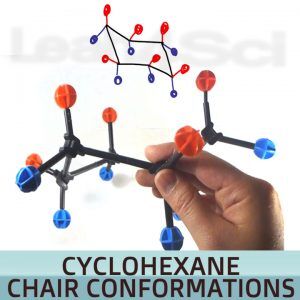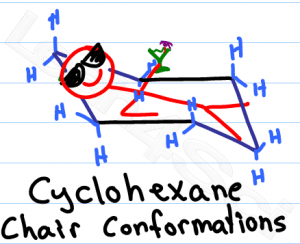 Cyclohexane is often depicted as a planar hexagon. However, with so much strain on the bonds, it prefers to adopt a chair conformation.
Cyclohexane is often depicted as a planar hexagon. However, with so much strain on the bonds, it prefers to adopt a chair conformation.
This tutorial series will teach you everything from understanding these structures, drawing chair conformations, and ranking stability based on substituents.
Once you feel confident with the material go ahead and try the Chair Conformations Practice Quiz!
Would a Model Kit help you? Watch How to Use Your Organic Chemistry Model Kit.
Video 1 – Introduction to Chair Conformations of Cyclohexane
 “Why does cyclohexane have to be in a chair conformation?How do I know which carbon goes up or down?” Learn this and more in video 1 of the chair conformation series. Learn how to recognize a chair, what it represents (with a model kit and on paper) and the nature of axial and equatorial substituents.
“Why does cyclohexane have to be in a chair conformation?How do I know which carbon goes up or down?” Learn this and more in video 1 of the chair conformation series. Learn how to recognize a chair, what it represents (with a model kit and on paper) and the nature of axial and equatorial substituents.
Drawing Chair Conformations & Ring Flips
 Chair conformations are tricky to draw. While orgo is NOT an art class, if your substituents are ambiguous you may lose points.
Chair conformations are tricky to draw. While orgo is NOT an art class, if your substituents are ambiguous you may lose points.
This tutorial (along with a tutorial video) show you my step by step method for drawing a hexagon, cyclohexane chair conformation, and simple ring flip method.
The focus of this tutorial is speed and simplicity to ensure maximum points and minimum wasted time/effort on your next quiz or exam.
Video 2 – Chair to Double Newman Quiz Challenge Question Solution
 This video walks you through the Chair Conformations Practice Quiz bonus question B – Converting a cyclohexane chair conformation to double Newman Projections.
This video walks you through the Chair Conformations Practice Quiz bonus question B – Converting a cyclohexane chair conformation to double Newman Projections.
Video 3 – Cyclohexane Ring Flip and Boat Conformation
 This video breaks down how cyclohexane ring flips occur with both a model kit and on paper; also you will see time-saving tips on which substituents are axial/equatorial, a walk through of the chair energy-diagram, examples, and more.
This video breaks down how cyclohexane ring flips occur with both a model kit and on paper; also you will see time-saving tips on which substituents are axial/equatorial, a walk through of the chair energy-diagram, examples, and more.
More videos to come


